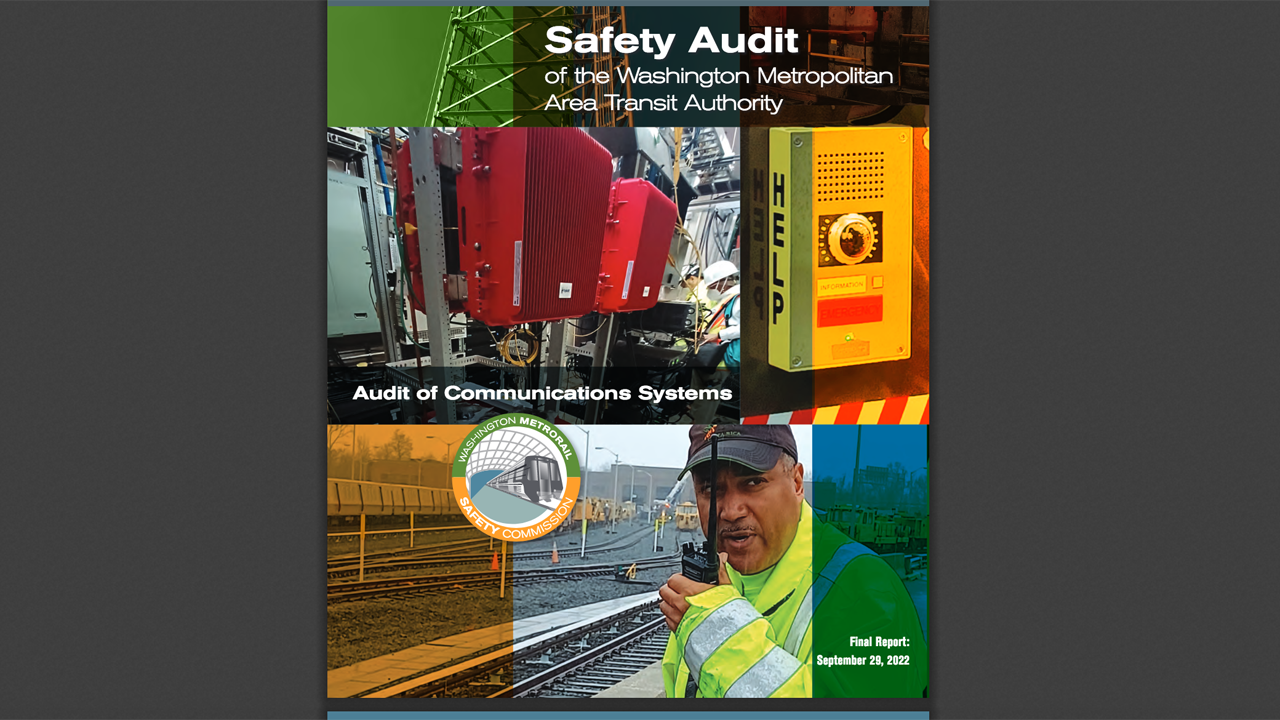
WMATA Communications Systems Audit Report Released
Written by Marybeth Luczak, Executive Editor
Washington Metropolitan Area Transit Authority’s (WMATA) Metrorail rapid transit system has safety gaps related to communications system training, supervisory oversight, safety promotion, maintenance, documentation, hazard identification, and procedural compliance, according to a 2022 Washington Metrorail Safety Commission (WMSC) audit report released Sept. 29. As a result, WMSC has issued nine findings requiring WMATA to develop corrective action plans, plus two recommendations that the transit agency must address.
“Metrorail’s communication systems, such as radios and radio infrastructure and public address systems, play a critical role in safe operations, emergency response, and numerous specific processes and procedures required to ensure the safety of Metrorail riders, workers and first responders,” according to the WMSC audit report (download available below). “The audit’s scope includes the examination of communications systems, including radio communications and other related equipment, as well as associated maintenance, training and engineering. Areas assessed relating to these topics include operational practices, processes and policies, as well as implementation and compliance.”
WMSC noted that Metrorail is continuing work on long-term plans to install and activate a new radio system. That project was nearly 50% complete at the time of the audit, with approximately 80% of below-ground work done and 14 of 27 above-ground towers completed. Additionally, WMATA purchased 5,400 portable, multiband digital radios, most of which had been distributed to personnel, to improve radio communications throughout the Metrorail system, according to the report.
The nine WMSC findings are:
- “Metrorail does not have adequate supervisory oversight and safety promotion to ensure that approved preventative maintenance inspections (PMI) are properly completed to ensure the safety of the rail system. Communications personnel are not using correct and current forms and processes necessary to ensure that safety-critical communications systems are appropriately and safely maintained.” As part of the minimum corrective action, WMSC said, “Metrorail must ensure safety promotion activities are performed to make certain all personnel are informed about the importance of and how to complete forms and to inform personnel of any changes to forms or processes.”
- “Metrorail does not have sufficiently detailed instructions and procedures specifying how to inspect and maintain each communications asset. For some assets, there are no instructions or procedures at all.” As part of the minimum corrective action, WMSC said, “WMATA must develop standard PMI forms, procedures and instructions for every communications system.”
- “Metrorail is closing preventative maintenance work orders without correcting known deficiencies, which does not comply with its Systems Maintenance (SMNT) Maintenance Control Policy.” As part of the minimum corrective action, WMSC said, “WMATA must develop and implement additional training, supervisory oversight and safety promotion to ensure adherence to their SMNT Maintenance Control Policy, Section 25, which requires that if a problem is encountered during a PMI that requires corrective action, the technician will create a corrective maintenance work order for the discovered problem and link the corrective maintenance work order to the preventative maintenance work order.”
- “Metrorail personnel are not effectively communicating, responding to and identifying issues related to trouble calls pertaining to communications systems. Metrorail closes communications-related ‘corrective maintenance’ (repair) tickets without effectively identifying, documenting and addressing issues.” As part of the minimum corrective action, WMSC said, “Metrorail must require personnel to document detailed information regarding identification and troubleshooting procedures that were attempted when responding to corrective maintenance work orders.”
- “Metrorail hazard logs are not being kept or maintained.” As part of the minimum corrective action, WMSC said, “WMATA must develop and implement a procedure for communications personnel to identify, document and mitigate hazards. Relevant personnel must be trained in hazard identification and tracking.”
- “Metrorail has insufficient training for communications personnel, including on-the-job training (OJT) that SMNT itself describes as deficient, and a lack of requirements to ensure that personnel only work on equipment they are trained on and capable of maintaining as required by the PTASP.” As part of the minimum corrective action, WMSC said, “WMATA must review and update training curricula for communications personnel to include refresher training and training more specific to specialized job functions, including PMIs.”
- “Metrorail does not have schematics, manuals and other materials in each Communications Room required by Metrorail’s Communications Room Bi-weekly Cleaning and Inspection PMI.” As part of the minimum corrective action, WMSC said, “Metrorail must institute a process to ensure and document that all communications rooms have current manuals, schematics and pertinent materials, and that these documents are stored in a well-organized and accessible manner.”
- “Metrorail lacks the safety assurance and safety promotion activities required to ensure that only current and calibrated radios are in use as required by Metrorail instruction and procedure, creating a risk that this safety equipment will not properly function when needed.” As part of the minimum corrective action, WMSC said, “Metrorail must ensure any remaining analog radios still in use systemwide are disabled and decommissioned.”
- “Metrorail communications rooms have signs of recurring water, dirt and dust intrusion. Metrorail is also improperly storing equipment in these rooms. Components in these rooms therefore may not function as required for the safety of riders, workers and first responders.” As part of the minimum corrective action, WMSC said, “WMATA must conduct a special inspection of all communications rooms to check for water intrusion or signs of water intrusion.”
The WMSC audit report also included these two recommendations:
- Because “[t]here is no comprehensive plan to maintain staffing of existing positions at all grades through timely hiring practices,” a possible corrective action may be for Metrorail to “conduct an analysis of recruiting and retention practices to determine the best approach and resources necessary to maintain the optimal level of staffing of highly qualified professionals and act upon such an assessment.”
- Because “[s]ome job descriptions have not been updated since the 1970s and 1980s and do not reflect current job responsibilities and necessary qualifications,” a possible corrective action may be for Metrorail to “review and update communications job descriptions to reflect the current requirements of the role, including experience and expertise in the subject area.”
Next Steps
WMATA is now required to propose corrective action plans (CAP) for each finding and to respond to each recommendation no later than 30 days after the audit report’s issuance, according to WMSC. Each proposed CAP “must include specific and achievable planned actions to remediate the deficiency, the person responsible for implementation, and the estimated date of completion,” and must be approved by WMSC prior to implementation, WMSC reported. Also, for each recommendation, “WMATA must either propose a CAP or submit a hazard analysis and associated documentation as required by the WMSC Program Standard.”



